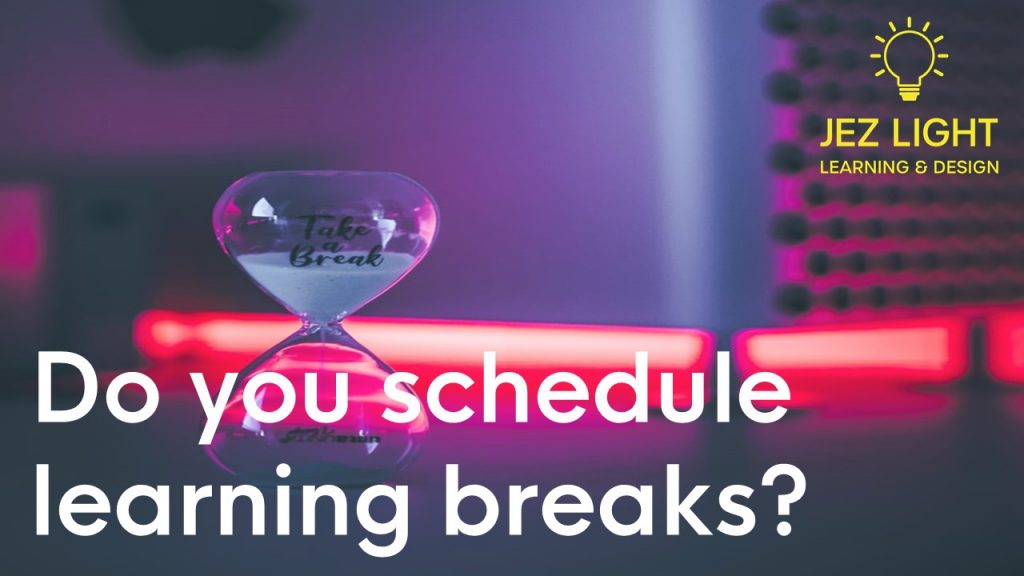Do you understand the importance of ‘learning breaks’?
We’ve all been there. It’s a brilliant training session, it’s all making sense and slotting together in your mind and then, oh, wait, what’s that?
Yep, your brain just got a little hot and overworked and has now decided it’s full and doesn’t want to absorb anymore information. No thanks. Not today. Brain closed for lunch. Argh!
The human brain is a clever machine that helps us do so much, but just like the individual it belongs to, it has a limit when it comes to assimilating new information.
It’s different for everyone, we all have different capabilities and, in some cases, techniques to help us learn, retain and recall information, but everyone has a personal limit.
We were inspired by some recent research from John Sweller, who’s one of the leading influencers when it comes to learning science. He’s currently a professor at the University of New South Wales in Australia.
He’s already well known for his cognitive load theory which in its simplest form, means don’t clutter up learning with hundreds of irrelevant details that whilst interesting at the time, can actually cause the learners brain to overload with rubbish they just don’t need.
His latest research, that really sparked our interest, shows that regular breaks, when digesting learning, in whichever format, can help the human brain refresh its ‘working memory’ (you know, like the spare space you have on a computer to allow for all the work you do…if you run out of RAM then the computer itself slows down and doesn’t work effectively!
Now, for some of us, this is nothing new, and we’ve always designed training to include regular breaks, refreshers, signposts, summaries and various ways of refreshing the brain, but, this new study shows that the breaks might be needed a little more often.
He gives a brilliant example. He reckons that most of us cannot remember anything for more than about 20 seconds without repeating it in our heads or writing it down to make it stick. His example – when someone gives you a new phone number to remember, whilst you are already working on another task. It becomes apparent pretty quick that our grey matter starts to struggle quite quickly.
Just like when we used the computer analogy, the RAM needs to be readily available to help us think and compute. The more tasks we’re already doing slows down our processing speed. When you think about this, if it slows a computer down, then it’s bound to do the same to our brains.
He talks about making sure that by giving out smaller pieces of learning, with digestible chunks and shorter, more regular breaks, keeps the memory from being overloaded. Interestingly, his research finds that our memories can suffer from ‘resource depletion’ when they memory is getting worn out because we are using it excessively.
Remember when we used to attend all day workshops and then wondered why our brains were literally overheating or overwhelmed at the end of the day?
We’ve all had that moment of ‘I know I learnt stuff, but right now I can’t remember all of it’
So, how long are these breaks supposed to be? Literally just 5 minutes each time you cover about half an hour of learning can be all it takes. This restores the balance and refresh the working memory in order to be ready for the next round of information storing. Like anything, this research is in its early stages and needs more work, but credit where it’s due, it kinda makes sense.
It backs up previous studies that have shown that a phenomenon in Learning Science called the ‘spacing effect’ have shown for a while. It finds that learners take in information better if it can be spread out over time rather than rammed into one long session. If the memory is starting to tire and the brain starts to feel to full, the study shows smaller chunks, with regular smaller breaks would have provide a little respite and a little refresh.
So, what can we do to test out this interesting theory?
We suggest refreshing a simple session you already have written, where you already have some valuable evaluation data to compare.
Review the learning and the objectives, and drop in a few extra slides, every 30 mins, where there’s an opportunity to stop, and do something different. Allow the brain time to digest, refresh that working memory space and then begin again.
Take a look at the evaluation data and see if it shows an increase. You might be surprised at what you see,
We all know that bitesize is a massive trend in learning, but this shows we might still need to be allowing some extra cool down time more than we do now in order to get the best learning outcomes.

